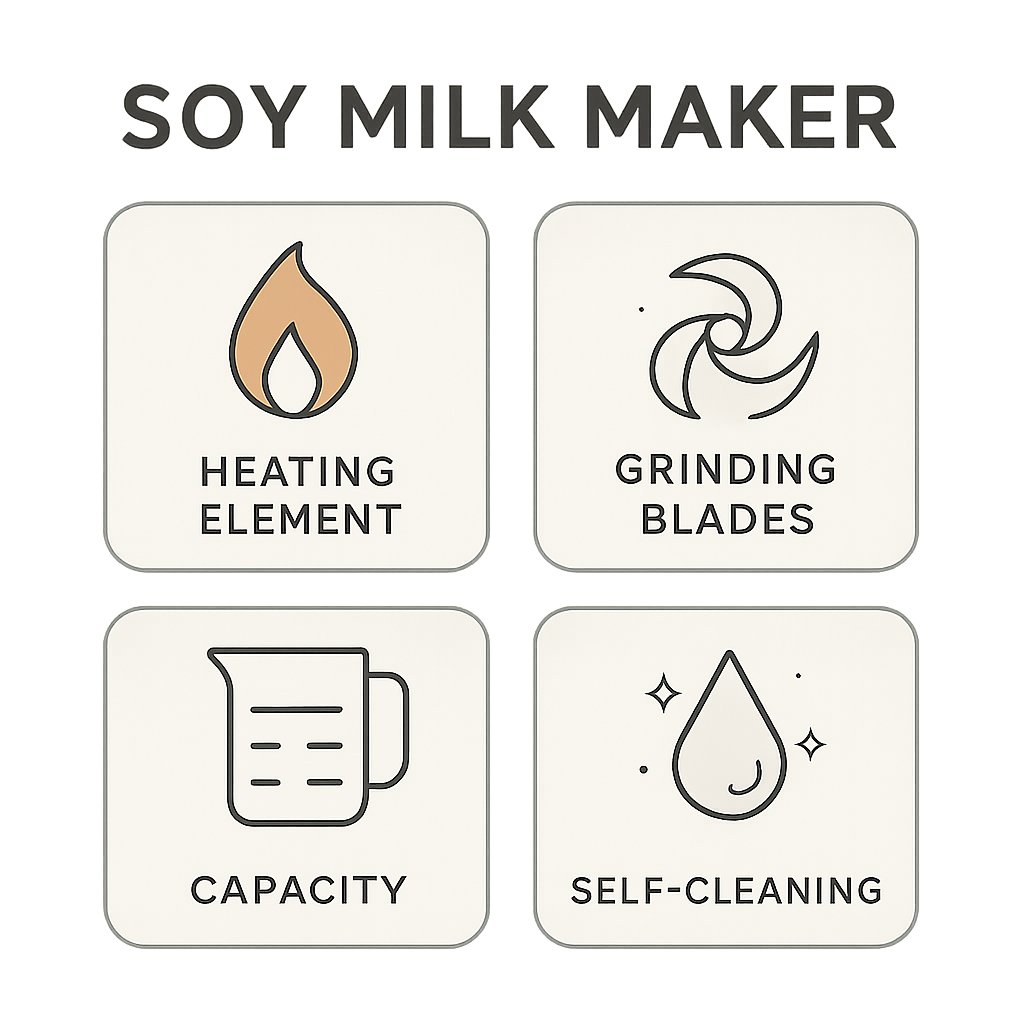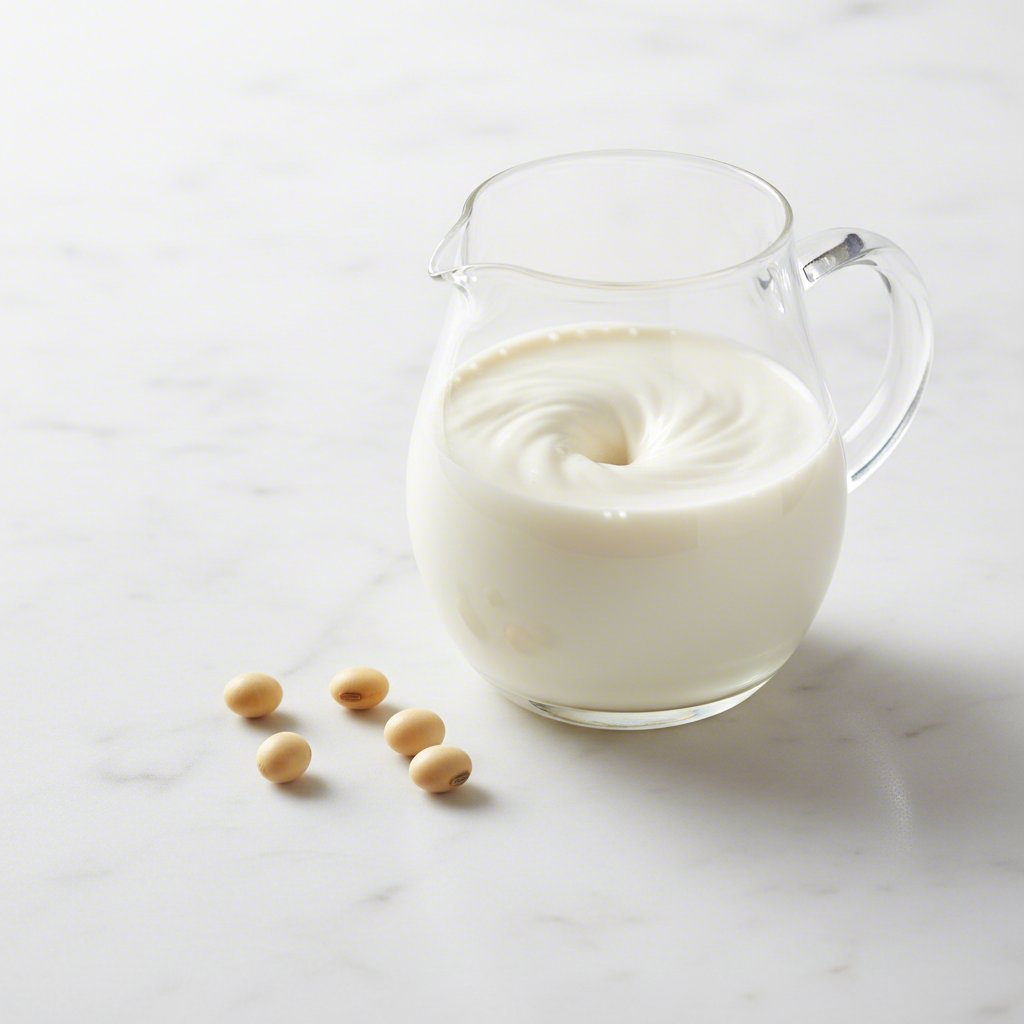TL;DR
Choosing the right soy milk maker comes down to one critical feature: a built-in heating element. Raw soybeans must be cooked for safe consumption, so a machine that heats and grinds is essential. Beyond that, prioritize features that match your lifestyle, such as a powerful grinding system for a smooth texture, a capacity that meets your household’s needs, and an easy-to-clean design, ideally with a self-cleaning function, for maximum convenience.
Key Factors for Choosing a Soy Milk Maker
Selecting the perfect soy milk maker can transform your daily routine, offering fresh, additive-free milk on demand. To make an informed decision, it’s crucial to understand the core features that differentiate these appliances. From safety to convenience, each component plays a role in the quality of your milk and your overall experience. The most important consideration is ensuring the machine can properly and safely process soybeans, which sets them apart from simpler nut milk makers.
A helpful approach is to consider your personal priorities. Are you looking for a machine that delivers the smoothest possible milk with no grit? Or is your main goal to save time with a fully automated, self-cleaning process? By evaluating the following factors, you can identify the model that best aligns with your needs.
Heating Function: The Non-Negotiable Feature
Unlike nuts and grains, soybeans must be cooked to be safely consumed. Raw soybeans contain compounds that can be harmful, but these are neutralized through heating. Therefore, the single most important feature in a soy milk maker is a built-in heating element. As noted by Serious Eats, without this function, you would need to manually cook the soybeans on a stovetop before processing them, which defeats the purpose of an all-in-one appliance. Machines like the SoyaJoy G5 and ChefWave Milkmade integrate heating directly into their cycles, ensuring the finished milk is ready to drink safely.
Grinding Power and Filtering System
The texture of your homemade soy milk is determined by the machine’s ability to grind the beans finely and filter out the pulp (known as okara). A powerful motor and sharp blades will pulverize soaked or dry beans into a smooth slurry. The filtering mechanism then separates the liquid milk from the solid particles. Some machines, like the SoyaJoy G5, require manual straining with an included sieve or a separate nut milk bag for the smoothest results. Others, like the ChefWave Milkmade, are designed to grind so finely that minimal pulp remains, and it often settles at the bottom, eliminating the need for a separate straining step. An effective filter is the key to avoiding a gritty or sandy texture.
Capacity and Batch Size
Soy milk makers vary significantly in size, from compact single-serving models to large family-sized pitchers. The Nutr, for example, is great for individuals, producing about 12 ounces per batch. On the other end, models like the Idavee Presto Pure can make over 64 ounces, ideal for households that consume a lot of milk. When choosing, consider that homemade soy milk typically lasts for 3 to 5 days in the refrigerator since it lacks the preservatives found in store-bought versions. It’s better to choose a capacity that matches your consumption habits to ensure freshness.
Ease of Cleaning
Making milk can be a messy process, and cleaning the machine is often the biggest drawback. Pulp can get stuck in fine mesh screens and around blades. Many modern soy milk makers now offer a self-cleaning function, which is a game-changing feature for convenience. The ChefWave Milkmade and MioMat both include automated cleaning cycles that wash the internal components with hot water and soap, draining the waste into a separate basin. For machines without this feature, look for designs with fewer parts, a dual-layer stainless steel body that’s easy to wipe down, and accessories that are simple to rinse immediately after use.
Top-Rated Soy Milk Makers: A Comparative Review
Navigating the market for soy milk makers can be overwhelming, but a few models consistently stand out for their performance, features, and user experience. Based on extensive reviews and testing, these machines cater to different needs, from the tech-savvy user seeking full automation to the budget-conscious buyer looking for multifunctional value.
SoyaJoy G5: Best Overall
The SoyaJoy G5 is a highly regarded machine that balances functionality and price. It features a robust heating element and seven pre-programmed functions for making milk from dry or soaked beans, as well as soups and porridges. Its large 50-ounce capacity is suitable for families.
- Pros: Large capacity, self-heating, multiple functions for versatility.
- Cons: Requires manual straining for the smoothest texture, as the built-in filtering isn’t as fine as some competitors.
- Best for: Users who want a reliable, large-capacity machine and don’t mind the extra step of straining.
ChefWave Milkmade: Best Smart Appliance
For those who prioritize convenience, the ChefWave Milkmade is a top-tier smart appliance. It offers specialized programs for different ingredients (soy, almond, oat, etc.), a fully automated process from grinding to dispensing, and a crucial automatic self-cleaning cycle. It handles everything without needing to pre-soak beans.
- Pros: Extremely convenient, automatic self-cleaning, produces very smooth milk, self-heating.
- Cons: Smaller 20-ounce capacity, slower processing time, and a higher price point.
- Best for: Tech enthusiasts and anyone who values a hands-off, mess-free experience.
Nutr Nut Milk Maker: Best for Single Servings
The Nutr is a compact and versatile machine perfect for individuals or small households. It includes a heating element, making it suitable for soy milk, and has presets for hot, warm, and room-temperature milk. It can also be used to boil water.
- Pros: Compact design, self-heating, versatile presets including a delay timer for pre-soaking.
- Cons: Small 12-ounce capacity and can overheat if multiple batches are made in quick succession.
- Best for: Individuals or couples with limited counter space who want fresh, single servings.
Almond Cow: Best for Large Batches (with a Caveat)
Despite its name, the Almond Cow can process soybeans, but it comes with a major caveat: it does not have a heating element. This means you must pre-cook the soybeans on a stove or simmer the finished milk for about 20 minutes to ensure it’s safe to drink. However, it excels at making large batches (up to 48 ounces) very quickly.
- Pros: Very fast (makes milk in about a minute), large capacity, simple one-button operation.
- Cons: No heating function (a critical drawback for soy milk), and cleaning the filter basket can be difficult.
- Best for: Households that make various types of plant-based milks and are willing to handle the extra cooking step for soy.
For even more in-depth reviews and to compare a wider range of models, including those for almond, oat, and other plant-based milks, Soy Milk Quick offers a comprehensive guide.
The Soy Milk Making Process: Soaking, Grinding, and Automation
Understanding the process behind making soy milk helps clarify why certain machine features are so important. The journey from a dry soybean to a glass of creamy milk involves several key stages: soaking, grinding, heating, and filtering. Different machines handle these steps with varying levels of automation, which impacts convenience, time, and the final quality of the milk.
The first decision point is often whether to soak the beans. Soaking soybeans overnight (for 8-12 hours) softens them, which can lead to a creamier final product and may be easier on the machine’s grinder. Many traditional recipes and machines like the Almond Cow require pre-soaking. However, for those who need milk on-demand, many modern machines like the SoyaJoy G5 have programs that can process dry beans directly, saving you the planning step.
Next is grinding and heating. As discussed, these are the core functions. High-end machines automate this seamlessly; you add beans and water, press a button, and the machine grinds the beans while simultaneously heating the mixture to the correct temperature. This integrated process is what ensures the milk is both smooth and safe. Less automated systems, or those without a heating element, force you to manage these steps separately, adding time and effort to the process.
Finally, there’s filtering and cleaning. Automation here is a luxury that significantly improves the user experience. A fully automated machine like the ChefWave not only filters the milk internally but also runs a cleaning cycle afterward. More basic models require you to pour the mixture through a separate filter and then manually wash all the components. The trade-off is typically between cost and convenience—the more a machine does for you, the higher its price tag is likely to be.

Is Making Your Own Soy Milk Worth It?
The question of whether to invest in a soy milk maker is a valid one, especially given the upfront cost. The answer depends on a cost-benefit analysis of your lifestyle, priorities, and consumption habits. For many, the advantages in taste, nutrition, and cost savings over time make it a worthwhile investment.
One of the most compelling reasons is taste. Freshly made soy milk has a richer, creamier flavor that is often described as far superior to commercial, pre-packaged options. As one expert noted in The Spruce Eats, homemade soy milk reveals what the beverage is truly supposed to taste like, without the watered-down consistency or masking flavors like vanilla common in store-bought versions. You also gain complete control over the ingredients, allowing you to avoid preservatives, thickeners, and added sugars. You can customize the sweetness and consistency to your exact preference.
From a financial perspective, making your own soy milk can lead to significant long-term savings. While the initial investment in a machine can range from under $100 to over $250, the cost of raw, dry soybeans is very low. If you are a regular soy milk drinker, the cost per serving of homemade milk will be a fraction of the price of buying cartons at the grocery store. The machine can pay for itself over time, especially for large families.
However, there is the factor of time and effort. While automated machines simplify the process, it still requires more effort than grabbing a carton from the fridge. You have to load the machine, wait for the cycle to finish, and handle the cleaning. For occasional drinkers, the convenience of store-bought milk might outweigh the benefits of making it at home. Ultimately, if you prioritize fresh taste, ingredient control, and long-term savings, a soy milk maker is an excellent addition to your kitchen.
